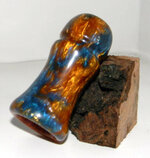I recently pick up an older paint pot and have it all ready for casting. The tank is rated at 110# but the pop-off valve goes at around 48#-50#. Is this going to be enough pressure to force colored PR into the voids of a worthless wood blank or should I replace the valve and try to get it up around 80#?
Thaks for your help
Well, manufacturers don't like to be sued so they play very safe with these issues so, having a pot rated at 110PSI (which is quite rare, considering the cheap stuff seen around...!) and a safety valve at half of the maximum tested pressure, is quite common so, and considering that for casting woods that have lots of cracks, small holes and other flaws with resin, regardless if is PR or Alumilite, you need as much pressure as possible and in my experience, anything under 80PSI, just doesn't do it so, you have 3 options;
*-1 Be too scared to make any valve modifications, due to what "some people will say about the issue, and leave it alone, losing the most important characteristic of your pot and that is, being factory tested at 110PSI, which always is a very safe imprint as if they classify it at such pressure, they know the pot will withstand higher pressures but then, would be getting too close to losing their safety margin of at least 25 to 50% of what they (factory) know the pot would withstand.
You don't want to run pressures too damn close to the pot "factory capabilities", not the very safe max. ratting printed on the pot, so making some "safe" alterations on the valve , is quite doable...!
*-2 Be brave and smart by getting the most out of the particular pot you have and, either putting a stronger spring on the valve if the valve is not a sealed unit, otherwise purchase a 100PSI safety valve and install it, you will have the pot safe and with sufficient pressure to do those "Swiss cheese type wood bits of wood" with the resin...!
*-3 Take the valve all together and use a pressure gauge, controlling the amount of air going in by what the gauge reads as you fill the tank.
However, this not the best practice, if you have a non-return valve in the system and a compressor capable of producing more that 100PSI pressure. The danger is that, not having the safety valve to release a intake of dangerous pressures produced by big compressors, you have the risk of blowing the pot.
What happens is, any non-return valve, as the ones find in tyres for example but the principle works for any non-return valves, as the air is going in the valve retains it from coming out, and you never will be able to put any more air in, if the pressure behind that valve is equal or superior than the compressor capabilities but, if the compressor is a big one, for example capable of producing 150PSI pressure, and the air inside that pot is already high or close to the pot capabilities then, the compressor's superior pressure, will continue to pump air through that valve until the pressure in between the pot and compressor reaches the compressor's max. pressure making capabilities, which by then, if the pot supports that pressure, the compressor can continue to work but unable to pump any more air in the pot or, if the pot is not built for such pressures, it will blow, or something will give on it, guaranteed...!
Conclusion:
It seems that you have an identical pot as mine that is also factory rated at 110 PSI and as such I would recommend the following.
*- Remove and seal any bits and odds in the pot that are not needed as they are only, places where the air can escape.
*- Make/get a tyre type non-return valve for your air intake, with a on/off tap just passed it (stop any air from coming out of the pot, accidentally...!
*- Get a 100PSI safety valve and replace with the one in the pot. If you can get the correct pressure safety valve, you can adjust to require pressure with a valve that can be dismantled for spring replacement or one of the adjustable safety valves bin our days.
Either adjusting the adjustable valve or getting the right spring for the valve, you require a normal tyre pressure gauge gun and a compressor that is capable to produce at least equal pressure to the maximum you want to achieve, as you can not reach 100PSI pressure in the pot, if the compressor only goes 80PSI (as explained above where pressures behind the non-return valve (pot end), have to be lower than what the compressor is capable of...!)
*- If you don't cast "worthless type blanks", what you've got, is more than sufficient for straight resin blanks casting...!
Disclaimer:
My suggestions and recommendations are based upon my own experience and own pot set up, which matches the factory ratings provided by the OP.
Pot set up suggested, is applicable for any casting pot, regardless of pressures required.
If you require to make pot modifications and are not comfortable or feel capable to do them, gather this all any other information you need, and find someone that is capable to perform these tasks safely.
PS: If money is no issue, buy a specialised high pressure ratting casting pot, made by well known and tested reputation...!
Good luck...!
Cheers
George

